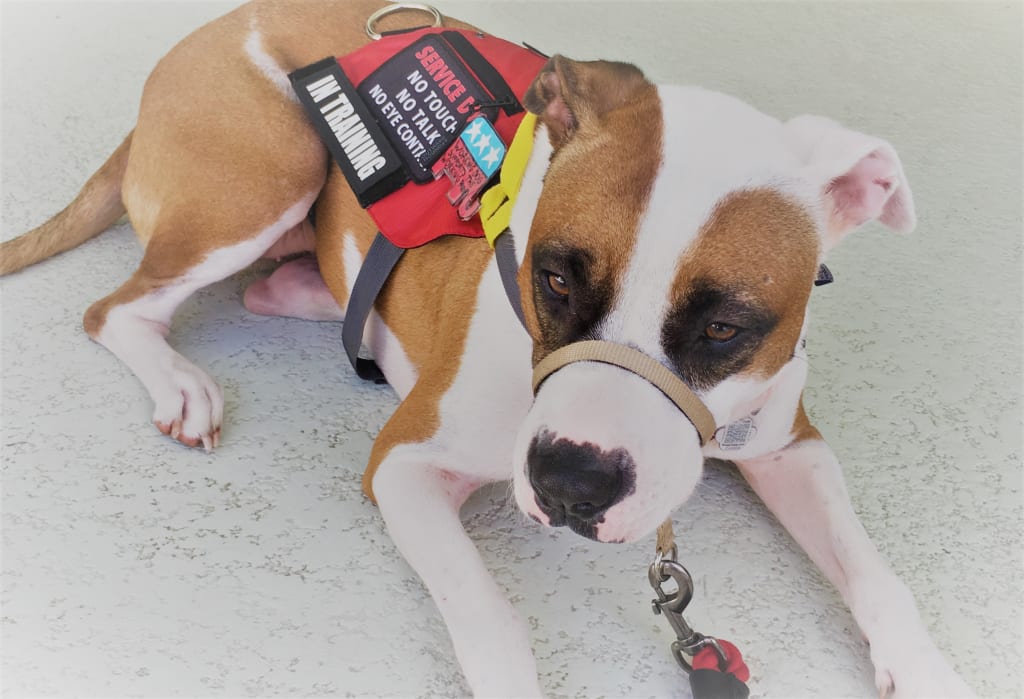What Not to Do Around Service Dogs
PTSD Service Dog Handler's Guide

I, too, was in the shoes of those who did not understand the acceptable public maneuvers for when a service dog and their handler were on the scene. We’ve all been there, making kissy noises, staring, petting… innocently enough we did not know the true rudeness, awkwardness, and inconvenience we imposed on the handler. As a current handler of a service dog, I am fully aware of the boundaries I so ignorantly crossed, as Harley’s and mine are crossed on the daily.
First, service dogs are different from therapy dogs or emotional support animals (ESAs) in that they are specifically trained to perform a task or tasks that mitigate their handler’s disability. Unlike the former two, service dogs have full access rights to any building, facility, or organization; in some states, Service Dogs in Training (SDiT) share those same rights. Also unlike ESAs or therapy dogs, service dogs are not required to wear a vest or special marking of indication, and their handlers are not required to provide documentation of registration or certification.
Second, employees and business owners are legally allowed to ask just two questions: “Is that a service dog required for a disability?” and “What task does he/she perform?” all without being legally able to ask for a demonstration. Only if the dog is acting up and creating a disturbance can the business kick you out of the store or facility.
It is common knowledge (or should be) that you should not approach any dog whether it is on or off leash for possibility that the dog might be dangerous. While that is not the case with service dogs, it is still inappropriate, especially if the dog is wearing a vest that might say something along the lines of “DON’T TOUCH.”
As a sufferer of PTSD, it is difficult enough when I must interact with the cashier or waitress, or any stranger in general. Let alone a stranger running up to me with "yappy" vigor asking to pet my dog. I cannot speak for other service dog handlers, but most handlers such as myself want space and to be ignored completely.
Speaking of PTSD, Harley’s vest patches indicate the disability she is trained to mitigate (others might say “epilepsy” or “mobility assistance,” etc.). It is downright inappropriate to ask what may have caused the PTSD. It may be out of curiosity, but the question is far too personal and unfitting for a social encounter. For some, the very question may CAUSE symptoms of their PTSD to flare up, inducing feelings of anxiety or even as far as flashbacks.
I have had too many people come up and pet Harley without asking. It not only startles me as an anxious person, but it startles my dog as she is still in training and is not fully used to public environments. Once when I allowed a woman to pet her, Harley walked away from her and tried moving nearer to me. The woman then proceeded to GRAB Harley’s leash and pull her closer to herself, so she could pet her. Not every encounter is as traumatizing as that, but the reason you cannot pet my dog is the reason she can have full public access.
It is important to remember not to distract the dog. If it’s not petting, it’s the kissing sounds and the whistling and the snapping. It is difficult for a dog to focus on one thing in the first place, being able to hear and smell everything around them. An SDiT can get distracted easily, in which we appreciate the training opportunity, but it was unsolicited. The dog is working and has an important task. Distracting and harassing the dog might make it miss an alert, not to mention interfering with an SD is a FEDERAL CRIME.
So I hope you’ve learned a thing or two about service dogs and what to do when you encounter one at the mall or a grocery store. Beware of not only the emotional stress you may be putting on a service dog handler, but the laws you are breaking too.







Comments
There are no comments for this story
Be the first to respond and start the conversation.